
|
|
21 November, 2001
I went out to the melt hole near our field camp with Dr. Jan Pawlowski and
Dr. Steve Alexander. This melt hole was not for dive collection because of
its 150-foot depth. (The divers are not allowed to dive more than 120
feet.) We refer to it as the "melt hole" because it was not blasted, but
went through the drill/melt process. It took two days to melt this hole
with the equipment that came in last week. A box corer was used to collect
sediment with forams for Dr. Pawlowski. A huge Weddell seal popped its head
up through the dive hole before we could even get the box corer in the
water. It seemed curious as it looked up at us with big eyes. Antarctica
tends to bring daily surprises.
The reason I wanted to come to Antarctica was to bring real science
research into classrooms and to pull others into learning. It's not just
"what" we learn, but "how" we learn that will encourage "true learners".
Science teaches skills that enhance the process of learning. It teaches how
to observe, ask questions, predict, investigate/test, and think. Science is
not just "what" we learn in a book. It is constantly changing, and there
are no set answers. What we learn may one day be disproved, or changed as
technology improves, or when other investigations prove another theory.
This is what makes science so exciting! Science is very much apart of our
every day lives, whether someone is finding the cure for cancer or
researching ways to protect the environment for future generations. The
Earth is not frail, human civilization is. Life as we know it can be
altered or changed if we do not understand the "science" to protect, or to
make informative decisions to maintain a healthy environment for human
habitation.
My joy of being in Antarctica is not just experiencing the continent,
although it is quite beautiful, but rather the people that I've met here.
It has been a real joy to talk to scientists about their projects in
Antarctica. I have been so fortunate to be with six incredible scientists
who are dedicated and enthusiastic about their work. I can't leave
Antarctica without bringing their science to you. They amaze me with their
knowledge, work ethics, and enthusiasm for their science research. Today, I
would like to introduce you to Dr. Jan Pawlowski. He is one of the most
dedicated people that I've ever met. Normally, he can be found at his
microscope in his "Antarctic lab". Today, I had photos that captured him
working in the field.
Dr. Pawlowski was born in western Poland. He immigrated to Switzerland in
1982 where he continued his study of biology. He received his basic
knowledge of forams from a "geologist perspective". Geneva, Switzerland was
a good place to study fossil forams at that time. He also spent six months
in New York City learning about living forams. At present, Dr. Pawlowski
works at the University of Geneva in collaboration with the Museum of
Natural History. He spends 80% or more of his time doing research. He also
teaches, organizes, and facilitates the learning of 10 students in his lab.
Once a year, he gives a course on Molecular Systematics for PhD or higher
levels from different universities in Switzerland. Dr. Pawlowski found and
leads the Molecular Systematic Group (MSG), Department of Zoology and
Animal Biology. Systematics is the scientific term for classification of
living organisms. Instead of classifying through morphology and anatomy
(external or internal characteristics or what an organism looks like), Dr.
Pawlowski does the classification according to molecules. His focus is on
DNA, which helps him identify the organism's ancestors, or whether
organisms are related or not related. The systematic approach was made
possible by a procedure referred to as PCR (Polymerase Chain Reaction).
After foram DNA is extracted, the PCR procedure can multiply a fragment of
a gene in order to get millions of copies of it. This makes it easier to
read the DNA sequence to determine the genetic type. This process allows
Dr. Pawlowski to build a "genealogical tree" in order to compare to other
sequences and to infer a relationship between them. Being able to read the
DNA sequence of an organism gives more information about the evolutionary
history of the organisms. Dr Pawlowski's group studies molecular evolution
of forams, but also the amoebas, animals (fishes, bats, and parasites) and
green algae.
Humans, yeast, bacteria, forams, and other living organisms all share
several of the same genes, but each has specific variable regions which
allow to detect different organisms by using specific PCR primers. By
getting the DNA, Dr. Pawlowski can identify, detect, and compare different
species. Dr. Pawlowski worked for two years to identify the specific primer
for forams. This makes it possible for Dr. Bowser to detect forams in the
sediment collected in Explorers Cove without physically sorting them under
the microscope. When sediment is sent back to his lab in New York, DNA
testing can detect forams in the sediment by using the universal primer for
forams. Dr. Pawlowski is building a database on the computer to identify
DNA sequences for specific species of forams. This DNA approach can save
valuable time by identifying forams in the sediment.
Dr. Pawlowski has traveled all over the world in his pursuit to study
forams. He first came to Antarctica to study living forams in 1998, then
again in 1999 and 2001. He has also gone to other Polar Regions, such as
Iceland and Spitzenbergen (North of Norway). In doing so, he can make a
comparison with the Arctic and Antarctic forams. Next summer, he will go to
Greenland. In March, he will return to Antarctica, but travel aboard the
German icebreaker (ship), the Polarstern, to the Weddell Sea. Other foram
projects include work with temperate forams and coral reef forams. Part of
his study is bio-geography, where he studies the distribution of organisms:
how organisms are distributed and appear in the sea. He has traveled to
Guam, Japan, Malaysia, Australia, Canada, Nova Scotia, Mexico, Puerto Rico,
the Mediterranean Coast in Africa, California, Florida, and along the East
Coast in the United States.
Explorers Cove in Antarctica is unique in that it allows scuba
accessibility to the bottom of the ocean that resembles the deep ocean. Dr.
Pawlowski is looking for early forams to study the history of forams. His
research has led him to conclude that single-chambered forams evolved
before multi-chambered forams. This conclusion, based on research, infers
that the single-celled forams, which are dominant in Explorers Cove, have
ancestors dating back to the Pre-Cambrian period. All groups of forams with
single chambers, such as Astrammina, must have ancient origins. Explorers
Cove is one of the few places in the world where Astrammina rara can be
found in abundance. Dr. Bowser and his team of divers are currently making
comparisons in nearby locations, such as Marble Point and near the
Herbertson Glacier. Dr. Pawlowski said that 50 species unique to this place
are found at Explorers Cove. Dr. Bowser's research this year is to help
determine the ecological conditions in Explorers Cove, which make Explorers
Cove so unique. Discussions at the dinner table have led to questions in
this search. Does the huge beach left by the retreating glaciers play a
role in providing the perfect habitat for Astrammina? Is it unique because
the currents are different? The water coming from under the Ross Ice Shelf
is not rich in food items that forams can exploit directly. Diving in
McMurdo indicates that there is more marine life in McMurdo, but no
Astrammina. Explorers Cove has very little meiofauna (worms, ostrocods, and
other things in the sediment). Meiofauna stirs up sediment and makes the
area more active. Do the single-chambered organisms, like Astrammina rara,
need calm conditions without much activity in order to thrive? Does algae,
like what I'm finding in the moat area, provide periodic nutrients when
washed back to sea? Questions are the basis of science. It's through
questions that we discover answers.
Dr. Pawlowski is a "true learner". When I teach, my goal is to help
students find this same passion and inquisitive nature. Dr. Pawlowski sums
it up by stating that, "There is always something to be discovered. Read
everything to get the background, but let you and your imagination, not the
text books, guide you." Dr. Pawlowski has an abundance of knowledge on
forams around the world, but what makes him so special is his excitement
for making new discoveries. The more he learns, the more he questions. I,
too, am just now realizing that the more I learn, the more I realize that
I'll never learn it all. Life is constantly changing, and one investigation
only leads to more questions. It's the pursuit of answers that make science
feel like we're opening a special gift box. The real learning and joy is in
the pursuit. Making a discovery is not the final answer, or the end
result.it's always subject to change. The gift is learning how to find the
answers to lead to new discoveries. Dr. Pawlowski is a wonderful role model
in teaching me how this should be done.

Dr. Jan Pawlowski is working with a box corer to collect sediment from the bottom of the sea floor.
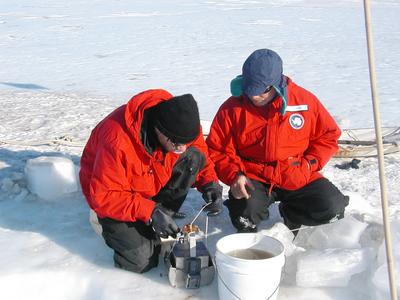
Dr. Pawlowski and Dr. Alexander with the box corer to collect sediment.

The box corer was lowered into the melt hole to the bottom of the sea. In order to get the corer filled with sediment back to the surface, Dr. Pawlowski had to manually pull it back up through the water column.

A huge Weddell seal popped its head up through the hole to see what Dr. Pawlowski was doing. I could hear its breathing before I even saw it.

The Weddell seal has such a cute face! He looks like he's saying he's sorry for getting in the way.

The Weddell would surface, then go back down. Dr. Pawlowski and Dr. Alexander waited for the seal to go on its way before finishing their task.
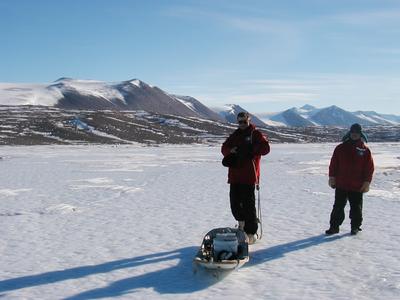
Dr. Pawlowski put the sediment with foram specimens in the banana sled.
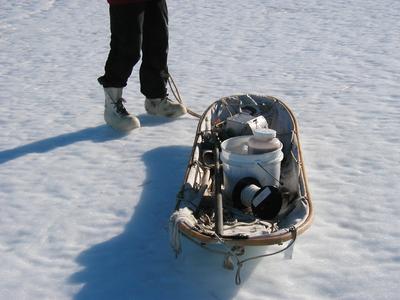
Banana sled with forams to be taken back to the lab.
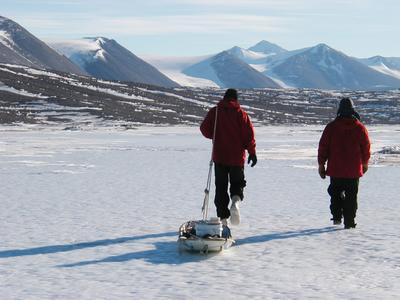
Dr. Pawlowski and Dr. Alexander heading back to the field camp.
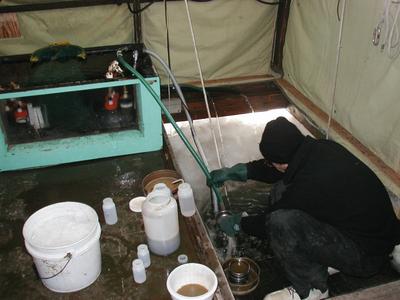
Dr. Pawlowski spent time sifting in order to get forams separated from the sediment.
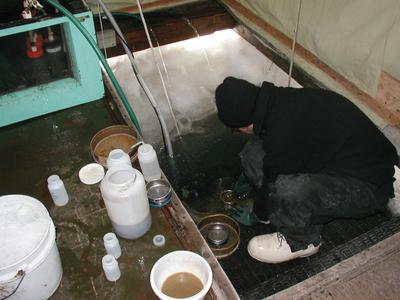
Dr. Pawlowski sifting through the sediment to get the forams.

Dr. Pawlowski is looking under the microscope to see which forams were found in that parcticular spot. It takes time to get to the science, but seeing the seal and Mt. Erebus, as well as working together to get the sample was an extra bonus.
Contact the TEA in the field at
.
If you cannot connect through your browser, copy the
TEA's e-mail address in the "To:" line of
your favorite e-mail package.
|
